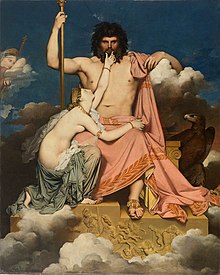Listo de Romiaj diaĵoj: Malsamoj inter versioj
| [kontrolita revizio] | [kontrolita revizio] |
Kani (diskuto | kontribuoj) Neniu resumo de redakto |
Kani (diskuto | kontribuoj) |
||
| Linio 20: | Linio 20: | ||
[[File:Altar twelve gods Louvre Ma666.jpg|thumb|left|''Di Consentes'' sur altaro.]] |
[[File:Altar twelve gods Louvre Ma666.jpg|thumb|left|''Di Consentes'' sur altaro.]] |
||
{{redaktata}} |
|||
====''Dii Consentes''==== |
====''Dii Consentes''==== |
||
[[Varro]] uses the name ''[[Dii Consentes]]'' for twelve deities whose gilded images stood in the [[Forum (Roman)|forum]]. These were also placed in six male-female pairs.<ref>[[Varro]], ''De re rustica'' 1.1.4: "eos urbanos, quorum imagines ad forum auratae stant, sex mares et feminae totidem.''</ref> Although individual names are not listed, they are assumed to be the deities of the lectisternium. A fragment from [[Ennius]], within whose lifetime the lectisternium occurred, lists the same twelve deities by name, though in a different order from that of Livy: ''Juno, Vesta, Minerva, Ceres, Diana, Venus, Mars, Mercurius, Jove, Neptunus, Vulcanus, Apollo.''<ref>[[Ennius]], ''Annales'' frg. 62, in J. Vahlen, ''Ennianae Poesis Reliquiae'' (Leipzig, 1903, 2nd ed.). Ennius's list appears in poetic form, and the word order may be dictated by the metrical constraints of [[dactylic hexameter]].</ref> |
[[Varro]] uses the name ''[[Dii Consentes]]'' for twelve deities whose gilded images stood in the [[Forum (Roman)|forum]]. These were also placed in six male-female pairs.<ref>[[Varro]], ''De re rustica'' 1.1.4: "eos urbanos, quorum imagines ad forum auratae stant, sex mares et feminae totidem.''</ref> Although individual names are not listed, they are assumed to be the deities of the lectisternium. A fragment from [[Ennius]], within whose lifetime the lectisternium occurred, lists the same twelve deities by name, though in a different order from that of Livy: ''Juno, Vesta, Minerva, Ceres, Diana, Venus, Mars, Mercurius, Jove, Neptunus, Vulcanus, Apollo.''<ref>[[Ennius]], ''Annales'' frg. 62, in J. Vahlen, ''Ennianae Poesis Reliquiae'' (Leipzig, 1903, 2nd ed.). Ennius's list appears in poetic form, and the word order may be dictated by the metrical constraints of [[dactylic hexameter]].</ref> |
||
Kiel registrite je 15:25, 28 maj. 2018

Granda nombro de antikvaj Romiaj diaĵoj estas konataj laŭnome. La plej familiaraj nuntempe estas tiuj kiujn la Romianoj identigis kun Grekaj similuloj, integrante Grekajn mitojn, ikonaron, kaj foje religiajn praktikojn en la Romia kulturo, inkludante Latinan literaturon, Romian arton, kaj religian vivon kiel ĝi estis spertita tra la tuta Imperio. Multaj el la Romiaj propraj diooj restas malhele, konataj nur laŭ la nomo kaj funkcio, tra surskribaĵoj kaj tekstoj kiuj estas ofte fragmentaj. Tio estas partikulare vera pri tiuj dioj kiuj apartenas al la arkaika religio de la Romianoj date reen el la epoko de la reĝoj, nome la tiel nomita "religio de Numa," kio estis retenita aŭ revivigita laŭlonge de la jarcentoj. Kelkaj arkaikaj diaĵoj havas Italikajn aŭ Etruskajn similulojn, kiel estis identigitaj kaj de antikvaj fontoj kaj de modernaj fakuloj. Laŭlonge de la Imperio, la diaĵoj de popoloj de la provincoj ricevis novajn teologiajn interpretojn laŭ la funkcioj aŭ atributoj kiujn ili kunhavis kun Romiaj diaĵoj.
Triopoj
- Arkaika Triopo: Jupitero, Marso, Kvirino.
- Kapitola Triopo: Jupitero, Junono, Minerva[1]
- Pleba aŭ Aventina Triopo: Cereso, Liber, Libera, date reen el la 493 a.K.[2]
Grupoj de dekdu
Lectisternium de 217 a.K.
Lectisternium estis bankedo por dioj, je kiu ili aperas kiel bildoj sidantaj sur kuŝejoj, kiel ĉeestantaj kaj partoprenantaj. Priskribante lectisternium de la Dekduaj Grandaj dioj en 217 a.K., la Aŭgustapoka historiisto Tito Livio metiss la diaĵojn en saks-ekvilibrajn parojn:[3]
Diaj maskl-inaj komplementoj kiaj tiuj, same kiel la antropomorfa influo de Greka mitologio, kontribuis al tendenco en Latina literaturo reprzsenti la diojn kiel "geedzaj" paroj aŭ (kiel en la okazo de Venuso kaj Marso) geamantoj.

Dii Consentes
Varro uses the name Dii Consentes for twelve deities whose gilded images stood in the forum. These were also placed in six male-female pairs.[4] Although individual names are not listed, they are assumed to be the deities of the lectisternium. A fragment from Ennius, within whose lifetime the lectisternium occurred, lists the same twelve deities by name, though in a different order from that of Livy: Juno, Vesta, Minerva, Ceres, Diana, Venus, Mars, Mercurius, Jove, Neptunus, Vulcanus, Apollo.[5]
The Dii Consentes are sometimes seen as the Roman equivalent of the Greek Olympians. The meaning of Consentes is subject to interpretation, but is usually taken to mean that they form a council or consensus of deities.
Vidu ankaŭ
Notoj
- ↑ Tito Livio, 1.38.7, 1.55.1–6.
- ↑ Dionizo de Halikarnaso 6.17.2
- ↑ Livy, 22.10.9.
- ↑ Varro, De re rustica 1.1.4: "eos urbanos, quorum imagines ad forum auratae stant, sex mares et feminae totidem.
- ↑ Ennius, Annales frg. 62, in J. Vahlen, Ennianae Poesis Reliquiae (Leipzig, 1903, 2nd ed.). Ennius's list appears in poetic form, and the word order may be dictated by the metrical constraints of dactylic hexameter.
